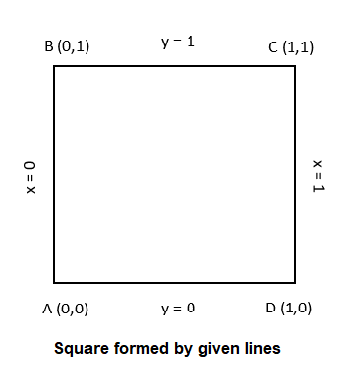
Equations of diagonals of squares formed by lines \[x=0\], \[y=0\], \[x=1\], and \[y=1\] are
A. \[y=x,\text{ }y+x=1\]
B. \[y=x,\text{ }x+y=2\]
C. \[2y=x,\text{ }y+x=\dfrac{1}{3}\]
D. \[y=2x,\text{ }y+2x=1\]
Answer
218.1k+ views
Hint: In the question, we are to find the equations of diagonals of a square formed by the given lines. Using the given equations of lines, a square is formed and we can able to find out its vertices. Then, the diagonals are calculated by the two points form.
Formula Used: The equation of the line, that is passing through $({{x}_{1}},{{y}_{1}})$ and $({{x}_{2}},{{y}_{2}})$ is
$y-{{y}_{1}}=\dfrac{{{y}_{2}}-{{y}_{1}}}{{{x}_{2}}-{{x}_{1}}}(x-{{x}_{1}})$
Where $m=\dfrac{{{y}_{2}}-{{y}_{1}}}{{{x}_{2}}-{{x}_{1}}}$ is said to be the slope of the line.
Complete step by step solution: Given that, a square is formed by the lines
\[\begin{align}
& x=0 \\
& y=0 \\
& x=1 \\
& y=1 \\
\end{align}\]
Plotting these in the graph we get the required vertices as below:

Then, the vertices formed by these lines are:
$\begin{align}
& A(0,0) \\
& B(0,1) \\
& C(1,1) \\
& D(1,0) \\
\end{align}$
Then, the required diagonals are $\overleftrightarrow{AC}$ and $\overleftrightarrow{BD}$.
By using the equation of line formula (with two points),
$y-{{y}_{1}}=\dfrac{{{y}_{2}}-{{y}_{1}}}{{{x}_{2}}-{{x}_{1}}}(x-{{x}_{1}})$
For the diagonal $\overleftrightarrow{AC}$, the vertices are $A(0,0);C(1,1)$
So, the equation of the diagonal is,
$\begin{align}
& y-0=\dfrac{1-0}{1-0}(x-0) \\
& \Rightarrow y=x\text{ }...(1) \\
\end{align}$
For the diagonal $\overleftrightarrow{BD}$, the vertices are $B(0,1);D(1,0)$
So, the equation of the diagonal is,
$\begin{align}
& y-1=\dfrac{0-1}{1-0}(x-0) \\
& \Rightarrow y-1=-x \\
& \Rightarrow x+y=1\text{ }...(2) \\
\end{align}$
Therefore, the required diagonal lines are $y=x;x+y=1$.
Option ‘A’ is correct
Note: Here we may go wrong with the vertices. For finding the vertices, a graph is drawn for the given lines. Then, we can able to find the vertices of a diagonal.
Formula Used: The equation of the line, that is passing through $({{x}_{1}},{{y}_{1}})$ and $({{x}_{2}},{{y}_{2}})$ is
$y-{{y}_{1}}=\dfrac{{{y}_{2}}-{{y}_{1}}}{{{x}_{2}}-{{x}_{1}}}(x-{{x}_{1}})$
Where $m=\dfrac{{{y}_{2}}-{{y}_{1}}}{{{x}_{2}}-{{x}_{1}}}$ is said to be the slope of the line.
Complete step by step solution: Given that, a square is formed by the lines
\[\begin{align}
& x=0 \\
& y=0 \\
& x=1 \\
& y=1 \\
\end{align}\]
Plotting these in the graph we get the required vertices as below:

Then, the vertices formed by these lines are:
$\begin{align}
& A(0,0) \\
& B(0,1) \\
& C(1,1) \\
& D(1,0) \\
\end{align}$
Then, the required diagonals are $\overleftrightarrow{AC}$ and $\overleftrightarrow{BD}$.
By using the equation of line formula (with two points),
$y-{{y}_{1}}=\dfrac{{{y}_{2}}-{{y}_{1}}}{{{x}_{2}}-{{x}_{1}}}(x-{{x}_{1}})$
For the diagonal $\overleftrightarrow{AC}$, the vertices are $A(0,0);C(1,1)$
So, the equation of the diagonal is,
$\begin{align}
& y-0=\dfrac{1-0}{1-0}(x-0) \\
& \Rightarrow y=x\text{ }...(1) \\
\end{align}$
For the diagonal $\overleftrightarrow{BD}$, the vertices are $B(0,1);D(1,0)$
So, the equation of the diagonal is,
$\begin{align}
& y-1=\dfrac{0-1}{1-0}(x-0) \\
& \Rightarrow y-1=-x \\
& \Rightarrow x+y=1\text{ }...(2) \\
\end{align}$
Therefore, the required diagonal lines are $y=x;x+y=1$.
Option ‘A’ is correct
Note: Here we may go wrong with the vertices. For finding the vertices, a graph is drawn for the given lines. Then, we can able to find the vertices of a diagonal.
Recently Updated Pages
JEE Advanced 2021 Physics Question Paper 2 with Solutions

JEE Advanced 2022 Chemistry Question Paper 2 with Solutions

Solutions Class 12 Notes JEE Advanced Chemistry [PDF]

Carbohydrates Class 12 Important Questions JEE Advanced Chemistry [PDF]

JEE Advanced 2026 Surface Chemistry Revision Notes - Free PDF Download

Revision Notes on Chemical Kinetics for JEE Advanced 2026 - Free PDF Download

Trending doubts
JEE Advanced Marks vs Ranks 2025: Understanding Category-wise Qualifying Marks and Previous Year Cut-offs

Difference Between Exothermic and Endothermic Reactions Explained

JEE Advanced Syllabus 2026

Top IIT Colleges in India 2025

IIT Fees Structure 2025

IIT CSE Cutoff: Category‐Wise Opening and Closing Ranks

Other Pages
JEE Main 2026: Application Form Open, Exam Dates, Syllabus, Eligibility & Question Papers

Derivation of Equation of Trajectory Explained for Students

NCERT Solutions for Class 11 Maths Chapter 10 Conic Sections

NCERT Solutions for Class 11 Maths Chapter 9 Straight Lines

Hybridisation in Chemistry – Concept, Types & Applications

NCERT Solutions For Class 11 Maths Chapter 8 Sequences And Series




